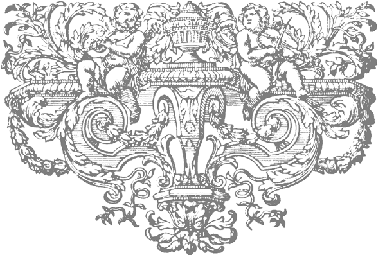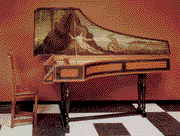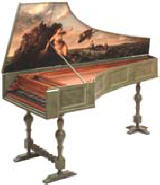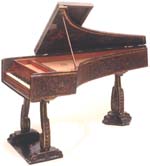The evolution of my interest in the Neapolitan
A new passion!
How I
became interested in the Neapolitan School of harpsichord building
The purchase of an anonymous Neapolitan
harpsichord
The anonymous Neapolitan harpsichord in the
Russell Collection of Early Keyboard Instruments
How I became
interested in the Neapolitan School of harpsichord building.
As long ago as 1974 I worked
with John Barnes, late curator of the Russell Collection of Early Keyboard
Instruments at the University of Edinburgh, on the restoration of an anonymous instrument from the
Royal College of Music
(Catalogue number RCM 175) . This
harpsichord had a sharply-pointed tail, a case made of maple or sycamore rather than the
usual cypress, the keyboard was raised above the baseboard on a frame attached
to the baseboard, the usual scrolls beside the key touchplates were replaced
with beautifully-carved female figures, and there was an amazing proliferation
of mouldings decorating the delicate case. It is, as I later came to
realise,
a highly typical example of a Neapolitan harpsichord.

Anonymous harpsichord attributed by me to Onofrio Guarracino, Naples, c.1660
Royal College of Music, London, Cat. No. 175
Many years later, at a
conference of the American Musical Society, I heard
John Koster talking about
Neapolitan harpsichords in connection with the work that he was doing for the
catalogue of the Musical Instrument Section of the Boston Museum of Fine Arts. I realized that the the instrument from the
Royal College of Music must also have been built in Naples. And I also realized that some of the instruments
that I had worked on in the
Museo Nazionale degli Strumenti
Musicali in Rome were made in Naples. Then, by
sheer coincidence, I saw a single-manual harpsichord by Onofrio Guarracino dated
1651 in
the workshop of Andrea di Maio, an ex-student of mine, in Rome. This was the first harpsichord that I had
seen that was signed by a Neapolitan harpsichord builder and was therefore an
instrument which was definitely made in Naples. Because of its importance to
the other instruments that I suspected were made in Naples, I then decided to study this instrument very carefully.
I also happened to be able to
purchase an original Italian harpsichord.
Using my geometrical method to determine where it was made (see:
Geometry and the Unit of Measurement) I was able to show that this instrument was also made in
Naples (for the analysis and the procedure used see:
Determination of the centre of construction
- 64Kb).
Following shortly on this I
analysed the anonymous single-manual harpsi64chord in the Russell Collection of
Early Keyboard Instruments (see
The anonymous Neapolitan harpsichord in the
Russell Collection of Early Keyboard Instruments at the University of Edinburgh) using the same method and was able to show that it was also made in Naples
(see:
The Russell Collection anonymous harpsichord
and the Neapolitan oncia - 33Kb.)
By now I had examined very
closely many instruments, all clearly made in Naples. It was clear that these instruments were totally different in
their construction and sound from those made in Northern Italy during a
contemporary period. Indeed I began to
realize that there is probably as much difference in the sound between a
Neapolitan harpsichord and a Venetian harpsichord as there is between a
Venetian harpsichord and a Flemish Ruckers harpsichord!
My interest was fired and I wanted to know more!!
Go back to the top of the document
![]()
The purchase
of an anonymous Neapolitan harpsichord.
In April of 1991 I was fortunate
enough to be able to buy an historical Italian harpsichord from a private owner
in Brussels. A photograph of this instrument
with some details of its original case and lid painting can be seen by clicking
on the image below.
Since buying this instrument I
have examined it closely and made a detailed report on its condition, history,
and provenance. I have decided that the
instrument is sufficiently robust to be restored back to playing condition, and
I plan eventually to do this. As
explained in the details given with the link to the image above, the original
case and lid painting has disappeared and so I have since had a new case
built. This case was painted in 2000 by
Stefano Pessione and given a new lid painting.
This painting and some details about it can be obtained by clicking on
the image below:
Recent work by me has shown that
this instrument was made in Naples.
Further details about this work can be obtained by clicking on the link
below:
Determination of the centre of construction
of this harpsichord
The discovery that this
instrument was made in Naples, and the need to study other instruments also
made in Naples as part of the background work necessary prior to the
restoration of the instrument has further stimulated my interest in Neapolitan
harpsichords.
This
instrument has recently been sold
as a restored and playing
harpsichord. Full reports on its
condition, origins and a restoration proposal are available. For further details contact any of the
addresses given in:
Contact Details
Go back to the top of the document
![]()
The anonymous Neapolitan
harpsichord in the Russell Collection of Early Keyboard Instruments at the
University of Edinburgh
This harpsichord is a typical
Italian harpsichord from the beginning of the seventeenth century. An elaborate analysis of the alterations to
this instrument during the historical period by John Barnes, the late curator
of the Russell Collection, showed that the original compass was C/E to f3
and that it had a number of enharmonic split accidentals. The compass of the instrument is now C to d3
chromatic.
The sound of this instrument is
crisp and pungent and has a constant quality that balances well over the whole
of the compass. It articulates trills
and ornaments particularly well.
Because of the excellent balance of the various parts of the compass the
instrument plays contrapuntal music, where each of the different voices
needs to take an equal part, clearly without one part dominating any other.
Recent work by me has
also shown that
this instrument was made in Naples.
Further details about this work can be obtained by clicking on the link
below:
The Russell Collection anonymous harpsichord
and the Neapolitan oncia - 33Kb.
This was
therefore yet another Neapolitan
harpsichord, unrecognised until my analysis of the unit of measurement used in
its design and construction established its origins. The acclaimed musical
qualities of the instrument and the knowledge that it was made in Naplies whetted
my interest in the Neapolitan harpsichord-building tradition even further.
Further details can be found about this instrument on the Russell Collection Website (if you are clever enough to find it!!)
It is also discussed and compared with the Royal College of Music anonymous Neapolitan harpsichord RCM175 elsewhere on this site.
A listing of the characteristics of Neapolitan harpsichords
Go back to the top of the document
Return to the section on the building of some new Neapolitan harpsichords




